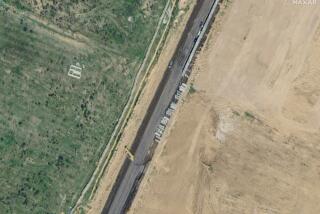In defense of Baghdad’s ‘walls’
- Share via
Baghdad — OVER THE last few days, there has been a lot of discussion in the media about the security barriers being erected in Baghdad. In The Times, among other publications, critics have complained that a “wall” between neighborhoods would divide Sunnis from Shiites and aggravate tensions.
Let me be very clear about this: These barriers are certainly not aimed at segregating different communities from each other. Rather, they are being put up to protect the Iraqi population by hindering the ability of terrorists to carry out the car bombings and suicide attacks that are taking the lives of innocent civilians.
The barriers are part of “Fardh al-Qanoon,” the Iraqi government-led security plan for Baghdad, which calls for a number of measures specifically designed to bring stability and security to Iraqis and to protect them from violence perpetrated by terrorists and militias:
Increased presence of security forces within Baghdad. In every part of Baghdad, Iraqi security forces and coalition forces — rather than militias — are now seen patrolling streets.
Joint security stations. There are 25 joint security stations in Baghdad, enabling Iraqi army and police to be out in the community, supported by coalition forces.
Baghdad Operations Command. This command has been established under the leadership of Iraqi army Lt. Gen. Abud Qanbar and manages all operations within Baghdad, supported by coalition forces.
Management of intelligence. The increased presence of security forces, and the corresponding sense of greater security, is increasing the amount of information provided by the local population on perpetrators of violence and the location of caches and bombs.
Intelligence-driven operations. Across Baghdad, operations are conducted day and night, based on intelligence, to detain potential terrorists.
Weapons cards. Only people authorized by the Ministry of Interior are allowed to legally carry weapons.
Checkpoints. Around Baghdad, there are checkpoints controlling entrance to the city.
Curfews. Every night, there is a curfew from 11 p.m. to 6 a.m.
Gated communities. Using temporary barriers, berms and other obstacles, entrance to markets and specific communities is controlled through checkpoints, which allow citizens to come and go but which prevent would-be attackers.
In addition to these security elements, the government of Iraq is increasing the quality and quantity of services provided across Baghdad.
It is our hope that Fardh al-Qanoon (which translates as “enforce the law”) will create the conditions for national reconciliation. It is only when different groups are convinced that their legitimate objectives can be achieved through a political process that violence in this country will substantially abate. We are beginning to see positive signs in certain parts of the country, where Iraqi citizens are working closely with the Iraqi security forces and coalition forces to rid their communities of terrorists.
Progress comes at different times, and sometimes when it is least expected. We must be patient. As soon as conditions are more stable, I’m sure the government will lift the curfew, replace or remove the barriers and reduce the number of checkpoints around the city.
More to Read
Sign up for Essential California
The most important California stories and recommendations in your inbox every morning.
You may occasionally receive promotional content from the Los Angeles Times.










